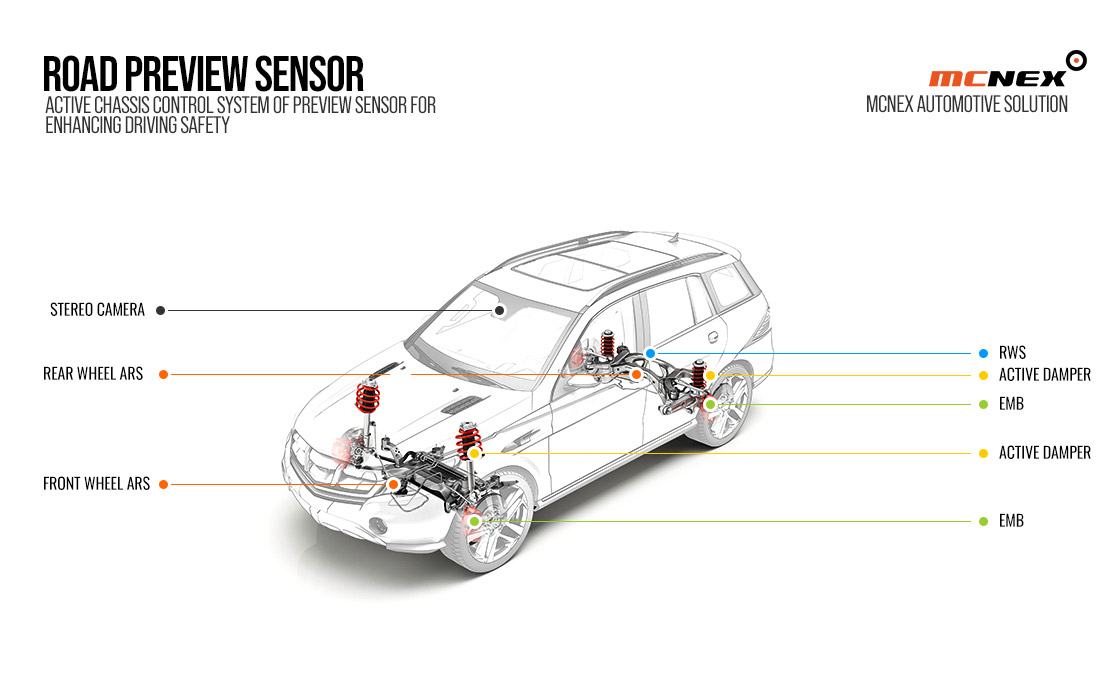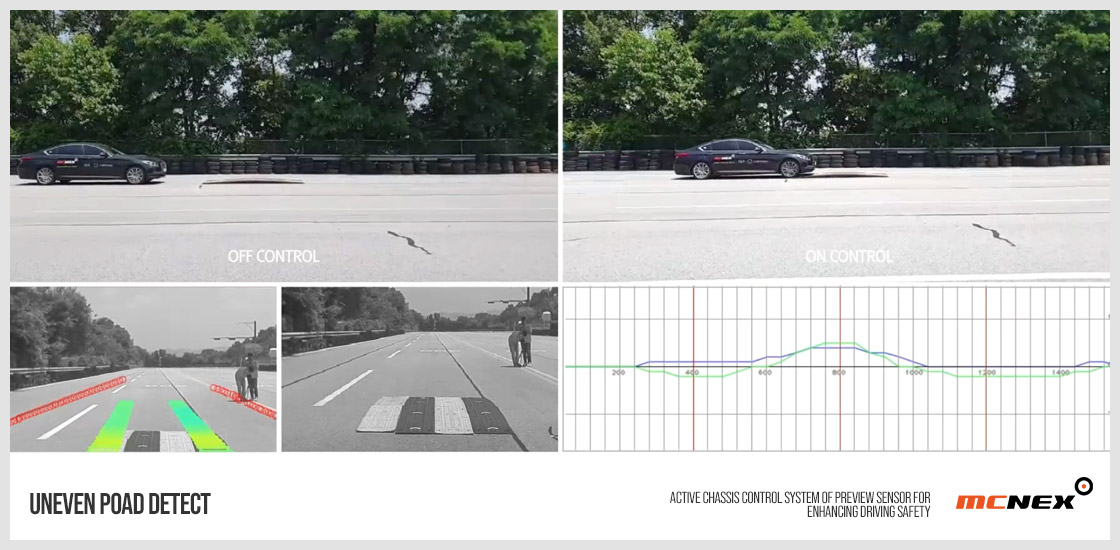NEWSROOM
Here we share with you various MCNEX stories.
- TitleMCNEX 'ROAD PREVIEW SENSOR' DATE 2024-04-07
-
MCNEX ‘ROAD PREVIEW SENSOR’
ACTIVE CHASSIS CONTROL SYSTEM OF PREVIEW SENSOR FOR ENHANCING DRIVING SAFETYMCNEX's "Road Preview Sensor" used in self-driving cars is an advanced technology used to detect road irregularities, such as bumps, potholes, and other surface abnormalities. These sensors mainly include LiDAR, radar, and cameras. These sensors collect a variety of information, including road curvature, slope, and road surface conditions, and provide data to the vehicle's suspension system and speed control system. This allows vehicles to drive safer and more comfortably and also helps them make more accurate driving decisions such as changing lanes, avoiding obstacles, and emergency braking.
Some luxury car manufacturers have already introduced Road Preview Sensor technology, providing the ability to adjust the vehicle's suspension system to road conditions. For example, a vehicle can recognize large potholes or road bumps in advance and adjust the suspension to minimize the impact. These features significantly reduce passenger fatigue during long drives.

Technical elements and operating principle of Road Preview Sensor
The core of Road Preview Sensor technology is to enable autonomous vehicles to identify road conditions in advance and respond appropriately. This technology combines a variety of sensors and advanced data processing algorithms to optimize the vehicle's driving path and performance. It is centered around a continuous loop of sensors, data analysis and actuation systems designed to proactively analyze and respond to road conditions, and how they interact within the system to enable vehicles to drive safely, efficiently and comfortably in a variety of driving environments.

1.Sensing and Perception
Sensor fusion
Road Preview Sensor integrates and uses data from various sensors such as LiDAR, radar, and high-resolution cameras. This allows the vehicle to precisely determine the curvature, slope, road surface condition, and obstacles of the road.
data fusion
By fusing data from these different sensors, we create comprehensive, real-time data about the vehicle environment. The fused data creates a dynamic model of the environment, including road geometry, location of obstacles, and movement patterns of nearby vehicles and pedestrians, to reliably detect and classify road features under a variety of conditions.
2. Data Processing and Decision Making
data processing
Collected data is processed in real time through advanced algorithms and artificial intelligence (AI) technology. During this process, the vehicle's computing system analyzes and predicts road conditions, obstacles, traffic situations, etc.
Decision
Based on the processed data, the system makes decisions on whether the vehicle needs to adjust suspension, speed, or steering angle depending on road conditions. This stage actively responds to road conditions to increase driving safety and provide passengers with a more comfortable driving experience.
3. Actuation and Vehicle Control
Suspension Adjustment
The system can improve ride comfort by adjusting the vehicle's suspension settings in real time to accommodate road surface irregularities. For example, you can soften the suspension before potholes or stiffen it to improve handling around corners.
Speed and steering control
The vehicle maintains a safe following distance, optimally navigates curves, and automatically adjusts speed to respond to detected obstacles or changes in road conditions. Steering adjustments are made to keep the vehicle within its lane and smoothly negotiate obstacles.
braking system
The brake system ensures safe stopping distances and is regulated to react quickly to sudden obstacles or changes in traffic flow, contributing to overall vehicle safety.
IMPORTANCE OF ROAD PREVIEW SENSOR
Road Preview Sensor technology plays an important role in improving the performance of autonomous vehicles by providing a sophisticated system for proactive analysis and response to road conditions. This technology will play a pivotal role in pushing the boundaries of what autonomous vehicles can achieve, significantly improving safety, efficiency and passenger comfort.
1. Road detection
The Road Preview Sensor analyzes the road ahead in real time through various technologies such as LiDAR, radar, and cameras, allowing the vehicle to brake through preemptive detection to identify potential hazards such as potholes, debris, and sudden obstacles in advance. By adjusting the system, you can reduce risks and improve the safety of your vehicle.
2. Improved response to environmental conditions
The system's ability to detect and interpret different surface conditions (e.g., wet, icy, or uneven roads) allows autonomous vehicles to detect and adjust their driving behavior early before encountering potentially hazardous situations, including reducing speed, etc. This may include optimizing approach angles or preparing the braking system to increase stopping distances.
3. Suspension adjustment for a comfortable rideOne of the most direct impacts on ride quality is the ability to adjust your vehicle's suspension settings in real time. Based on the data received from the Road Preview Sensor, the vehicle can adjust the suspension to relax depending on road conditions or maintain optimal handling when encountering curves or sudden changes in the road. This minimizes the effects of road irregularities, ensuring a smoother and more comfortable ride for passengers.
4. Speed and steering adjustments
In addition to the suspension, this technology allows you to fine-tune the vehicle's speed and steering. By predicting road conditions, the system slows down slightly or adjusts the steering angle just before a sharp curve to maintain stability and comfort, reducing the need for sudden vehicle adjustments in unexpected situations that can disrupt the ride.
5. Reduced fuel efficiency and exhaust gasesRoad Preview Sensor technology can contribute to more efficient driving patterns by optimizing the vehicle's speed and handling depending on road conditions. Optimal driving speed and smooth acceleration and deceleration reduce fuel consumption and, consequently, exhaust emissions. For electric vehicles, this can enable more efficient use of battery power and extend driving range.
6. Reduces wear and tearProactively coordinating vehicle movements reduces stress on vehicle components, reducing wear and tear. This not only extends the life of these components, but also reduces the frequency of replacement and repair, contributing to reduced resource consumption and waste generation.

Automobile manufacturers are integrating Road Preview Sensor technology into their vehicles in a variety of ways. For example, some luxury sedan models offer passengers an enhanced driving experience by pre-tuning the vehicle's suspension system to help it negotiate bumps in the road. It also helps autonomous driving systems make decisions such as obstacle avoidance and emergency braking more accurately.
Mercedes ‘Magic Body Control’
The system uses stereo cameras to pre-scan the road and adjust suspension settings to allow the vehicle to proactively react to upcoming bumps or potholes. This gives drivers and passengers an extremely smooth driving experience regardless of road irregularities.
Audi ‘predictive suspension’
This technology also analyzes road conditions through cameras and sensors, and adjusts the vehicle's suspension in real time to suit road conditions. Audi's system maximizes occupant comfort by minimizing vehicle impacts, especially when going over large bumps.
Tesla ‘Autopilot System’
It uses multiple cameras and sensors to recognize the surrounding environment and allows the vehicle to drive automatically based on this. Specifically, the system adapts the vehicle's behavior to road conditions, including functions such as lane changing, speed control, and parking. This is a good example of how Road Preview Sensor technology can improve a vehicle's autonomous driving capabilities.
Volvo ‘Pilot Assist System’
This function maintains the vehicle's speed and distance and helps it drive automatically within its lane. The system integrates cameras and radar to identify the lanes of the road, the distance to the vehicle in front, and the curvature of the road and steer the vehicle accordingly. This technology from Volvo is particularly useful for reducing driver fatigue on long distance drives.
These examples demonstrate how Road Preview Sensor technology is being integrated into modern vehicles to revolutionize the driving experience.
The proactive analysis and response capabilities of Road Preview Sensor technology are integrated into a wider range of autonomous driving systems, including navigation, obstacle avoidance, and vehicle-to-vehicle (V2V) and vehicle-to-infrastructure (V2I) communication systems. This integration allows vehicles to not only react to current conditions, but also predict road conditions based on planned route data, traffic updates, and environmental change prediction models.
This technology provides an important foundation for the development of future autonomous vehicles and can be further developed as data processing and AI become more sophisticated with the advancement of additional sensor technology or algorithms, and as connections between vehicles and infrastructure become more integrated. It has potential.
MCNEX 'ROAD PREVIEW SENSOR' - https://www.mcnex.com/en/business/020202.adas-solution